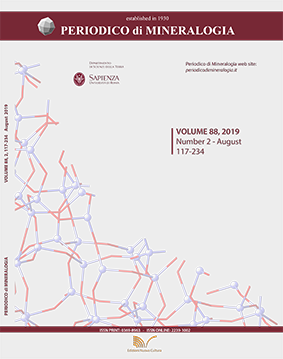Chemical variations and origin of tourmalines in laleh zar granite of Kerman (Southeast Iran)
DOI:
https://doi.org/10.2451/2019PM844Keywords:
Nodule tourmaline, radial tourmaline, vein tourmaline, schorl, dravite, Laleh Zar graniteAbstract
Tourmalines in the laleh Zar granite of Kerman are found in a variety of forms including: (1) nodule tourmaline ;( 2) radial tourmaline, and (3) vein tourmaline. Microprobe analyses of the tourmalines have revealed a wide compositional variation between schorl and dravite end members. These tourmalines belong to alkali group. Mg/Mg + Fe ratios for radial, nodule, and vein tourmalines range from 0.15 to 0.45, 0.25 to 0.62, and 0.20 to 0.61, respectively; and Ca /Ca + Na ratios for radial, nodule, and vein range from 0.17 to 0.33, 0.15 to 0.35, and 0.07 to 0.3, respectively. All tourmalines have lower Al content than 6 compared with the theoretical value of 6 in ideal schorl and dravite, showing the tourmalines do not contain enough Al to fill the Z-site. The values of X-Vacancy and Al in Y site of the three types of tourmaline are negligible. Nodule tourmalines have chemical and color-zoning patterns, whereas radial and vein tourmalines only have chemical-zoning patterns including significant fluctuations in Al, Fe, Mg, Na, Ca, and Ti. based on petrographic and chemical properties of tourmalines, vein tourmaline has been formed during a transition from magmatic to hydrothermal processes and radial tourmaline has been formed by mixing magmatic-hydrothermal fluids with an external fluid rich in Ca and Mg, whereas nodule tourmaline is probably the result of post-magmatic hydrothermal environment, through the influence of an external fluid that could for example have come from the wall rocks to the nodule.


